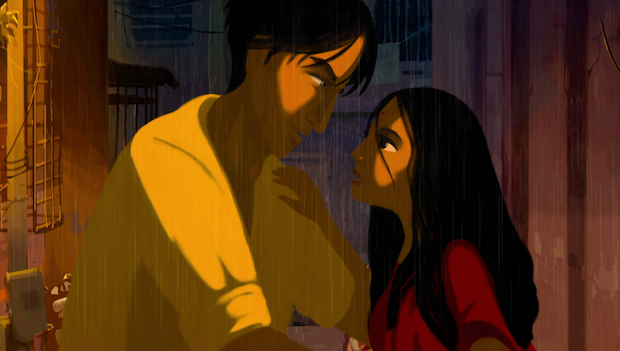Exclusive from the Toronto International Film Festival.
With a world premiere at the International Critics’ Week at the 76th Venice Film Festival, Gitanjali Rao’s ‘Bombay Rose’ appears at the Toronto International Film Festival, the only Indian film to be granted this double honour. The beguiling and topical animated feature follows multiple characters in Mumbai city, each one connected by a single red rose as they navigate life and love in the sprawling Indian metropolis. However, at its centre is the relationship between Kamala, a woman who makes strings of flowers, and the roses seller Salim. The two characters previously appeared in Rao’s 2014 short film ‘TrueLoveStory’, which played at Cannes.
Inspired by true events, the film is not only Rao’s debut directorial feature but
is also written and designed by her. The hand-painted images draw upon folk art and Bollywood melodrama, while the film delves into themes of poverty, corruption, and migration. Produced by Cinestaan Film Company and Les Films d'Ici, ‘Bombay Rose’ was in the making for five years. Born and based in Mumbai, Rao’s debut short film, ‘Printed Rainbow’, won the Kodak Short Film, Small Golden Rail, and the Young Critics awards at 2006 Cannes.
Uma da Cunha in conversation with Gitanjali Rao.
Have you always been inclined towards animation in your filmmaking? What is the cutting edge that animation has for you over other ways of filmmaking or presenting your work? Have you any had formal training in animation?
Yes, always. In all my films, the real proceeds into the imaginary world of the characters. Be it ‘Orange’, where the woman’s spirit takes on the form of a butterfly or ‘Printed Rainbow’ where the matchbox is the trigger for the old woman’s fantasy, even in ‘Chai’ where I transit from live action, into animation to bring alive the lost world of the characters. Similarly in ‘TrueLoveStory’ the fantasy world of Bollywood is the protagonist’s escape from reality. In ‘Bombay Rose’, since I have the luxury of a long format, my characters move seamlessly into their dream worlds from reality. I use different art styles that belong to their culture to enable them to escape into what might have been a reality ages ago. The audience is wont to expect something beyond reality when they watch animation. However, unlike conventional animation films, my dream worlds are fantastical in the psychological way, not just in space and time. I do not make fantasy creatures or unreal world, I simply recreate the time and world as it must have been in times of peace and beauty, more like an inner world of the mind and soul. This is nearly impossible in live action. I have not learnt animation formally but rather by working and training in studios like Ram Mohan Biographics where Ajit Rao taught us the fundamentals of animation. Then by doing workshops with international animation film makers like Jerzy Kucia, etc.

Bombay Rose has taken you over five years to finally present as a full-fledged film. I recall you were at Cannes some years ago with a teaser for the film. Did that visit help both creatively and financially towards completing the film?
Six actually. I was with TrueLoveStory in Cannes in 2014. That followed by the script lab and co-production lab at the NFDC Film bazaar, actually helped me find my Indian co-producers to partner with the French and make Bombay Rose happen!
What are the constraints, as you have experienced, in making animation shorts? And in this case, the far more serious task of an animation feature?
Financing mainly. There is no state finance for short films and in case of animation shorts, the time and budget are equivalent to a live action feature. But since I can animate, myself, apart from directing and scripting the film, I made shorts with no funding. That however, is impossible with feature length. Which is why it took me 25 years in the animation industry to complete my first feature; I started two others but managed to complete only this one.

Our distribution system is not conducive or open to accepting independent films, and I gather that animation is not really popular with our Bollywood-influenced audiences. What are your comments on this?
I hope it changes with the recognition Bombay Rose gets in the coming months.
Fortunately, other avenues such as OTT platforms (Netflix, Amazon Prime Video) are available for distributing animation films. Do you think this is helpful and does it lead to financial returns?
This is a question my producer can answer better than me. The problem with Indians is that they put the weight of this question on the creative person, not the business head. And the beauty of both, my French and India producers (Cinestaan) is that they do not expect me to answer this for them. They do it themselves.
Film festivals in India and abroad have given you a platform to screen your films. Has this helped in attracting promoters, leading to financial returns?
Time will answer this question. As this is my first feature with commercial gain attached to it.
The Venice and TIFF premieres will take your film internationally to other festivals. Are you at the liberty to announce any other screenings the film might have? Any invitations from MAMI, Film Bazaar or IFFI?
No, they are embargoed until their official announcements. But we are in Busan and BFI London which has been announced in this last week.
What next, Gitanjali? Any new animation ideas in progress?
Yes of course. Another animation feature but that will start only after I have weaned ‘Bombay Rose’ form my system.
An edited version of this article originally appeared on the online daily newspaper thecitizen.in